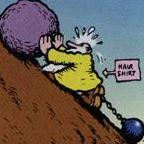Moriturus
Posts: 13
Joined: 2/13/2004
Status: offline

|
quote:
ORIGINAL: Les_the_Sarge_9_1
Welcome to wargaming dudes. That's how I did it for 20 years before computers.
Now you know why some of us actually CAN play wargames better than some.
Now that's not very nice of you.
I played wargames 20 years before computers as well. I now have a job, kids, a life, etc., and I don't want to spend a lot of time just figuring out how a game works before being able to play it. A good tutorial helps teach the game quickly, because it's much easier to understand various funcitons, concepts, etc. by actually doing them. Also, despite the best efforts of game designers, game manuals are not always models of clarity. A good example of a helpful tutorial is the one that comes with Korsun Pocket; it was very useful for getting me into the game quickly.
An AI opponent is essential if Matrix wants to market the game effectively; many people will not be able to, or will not want to, find human opponents. We can all berate the stupidity of current AI opponents, but it's still necessary to sell games. Bow to the inevitable . . . 
Now to specifics: what I'd like to see is a function where you can click on a hex and all of the units are laid out in detail full-screen. Also, a zoom feature wherein the area visible on the large map can be shrunk or enlarged would be very uselful in allowing players to change their focus on the amount of the battlefield that thy're interested in. Having a "rollershade" feature, where the functional portion of the screen can be removed with just a small tab to pull it back up, would also be helpful in allowing better map visibility. Finally, in close zooms, have tiling that shows most, if not all, of the attributes of all units in a hex and its six immediate neighbors.
No six-sided die like in Korsun Pocket; that's the cheesiest thing I've seen in computer gaming in a while, and I think it really is a major flaw in that game. The combat predictions and results in The Operational Art of War are much more realistic and interesting.
A user-friendly interface is very important, and it's hard to achieve with a complex wargame. Playtest, playtest, playtest, I guess . . .
Division breakdowns could be a real problem if there is no transaction costs for doing so. Making the divisional strengths of breakdowns significantly lower than the parent corps, and/or imposing a significant reforming penalty (or simply disallow reforming, perhaps allowing the division to be removed and thrown into the replacement pool) would limit the use of breakdowns. As to the fear that, e.g., the German player on the Eastern Front would use them to slow the Soviet player while re-grouping, well, that's what a rearguard is for, right?
Having some uncertainty as to the actual combat stregth of untried units is a good idea; it puts a premium on retaining veteran units and makes things more interesting when green units go into battle.
I don't think the game needs to be released with "alternative universe" scenarios, just with a good game editor. The alternate scenarios will then be designed by people who are much more interested in that sort of thing, leaving the game designers to concentrate on the game itself. Also, the game should of course have the widest possible methods of play: single-player, hot seat, PBEM, maybe LAN and Internet, and perhaps multiplayer.
And most important, make it FUN!
|
 Printable Version
Printable Version







 I tend to unknowingly cheat against myself without an AI.
I tend to unknowingly cheat against myself without an AI. 




 . My suggestions are therefore mostly cosmetic.
. My suggestions are therefore mostly cosmetic. 
 ). I do this as an attempt at communicating what I would like to see in CWiF...
). I do this as an attempt at communicating what I would like to see in CWiF...  Everybody bashes beer and pretzels...good stuff, IMHO.
Everybody bashes beer and pretzels...good stuff, IMHO.  New Messages
New Messages No New Messages
No New Messages Hot Topic w/ New Messages
Hot Topic w/ New Messages Hot Topic w/o New Messages
Hot Topic w/o New Messages Locked w/ New Messages
Locked w/ New Messages Locked w/o New Messages
Locked w/o New Messages Post New Thread
Post New Thread